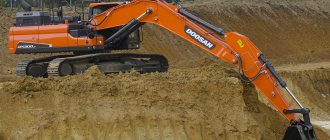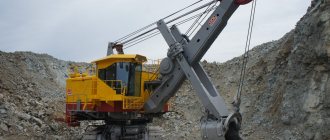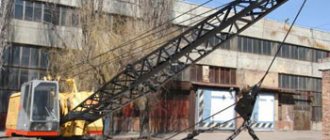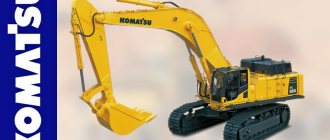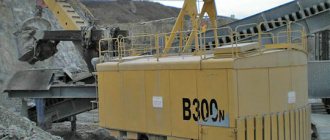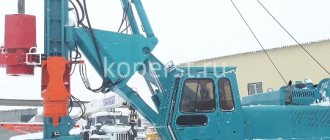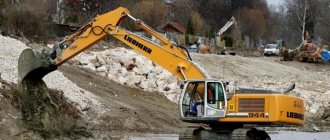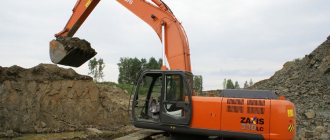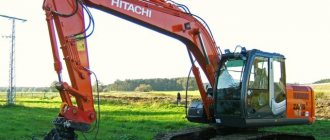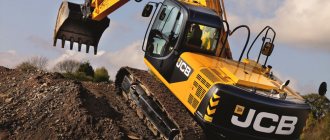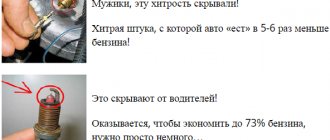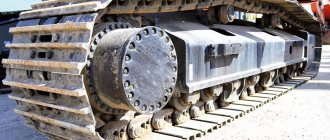The EO 2621 excavator is a universal medium-performance equipment belonging to the 2nd size category. The pneumatic chassis with a 4x4 formula provides increased cross-country ability and a wide range of driving advantages.
The model is designed taking into account modern trends in global mechanical engineering. This excavator combines high performance and reliability with low maintenance and ease of operation. According to its technical characteristics, the EO 2621 excavator is considered one of the best among equipment of this class.
Excavator EO-2621
The EO-2621 excavator, known in many regions of the former Soviet Union by the popular nickname “Cockerel,” is perhaps the most famous earth-moving unit in the vast expanses of the former USSR.
This universal bulldozer tractor on a pneumatic wheel chassis belongs to the second size group (there are 6 of these groups in total). It is designed for the development of various soils, from the first to the fourth categories. The EO-2621 excavator successfully copes with any soil, from sandy to heavy clay. Despite the fact that the extreme soil category for this technique is defined as fourth, its effective operation is possible in more difficult conditions if the working surface is first loosened. The meaning of the letter and number designation in the name of the excavator is as follows: “E” – excavator; “O” – single-bucket; “2” – belonging to the second group (it includes excavators whose weight is in the range of 6.3–10 tons); “6” – indicates that the excavator is mounted on the chassis of a serial tractor; “2” – the excavator’s attachments are rigidly mounted; “1” is the serial number of the model assigned by the manufacturer.
From an article by A. Ioffe on techstory.ru. Many thanks to the team of like-minded co-authors for their work.
Voronezh excavators
In 1870, an iron foundry and machine-building plant was founded in Riga, which in 1897 became the property of JSC Machine-Building, Foundry and Boiler Plant. The company manufactured equipment for the woodworking and leather industries, steam boilers and machines, as well as economizers. Due to the threat of the German occupation of Riga in 1915, the plant was evacuated to Voronezh and received the name “Joint Stock Company of Voronezh Machine-Building and Foundry in Riga. In 1922, the enterprise was given the name of the Third Communist International. This is how the name “Plant named after the Comintern” appeared.
In 1941, the company produced the country's first batch of the famous BM-13 rocket launchers, better known as Katyushas. Their tests were completed on July 2, and in October 1941 the plant had to be evacuated to Sverdlovsk. The return to Voronezh occurred only in 1943, and in 1946 the enterprise came under the jurisdiction of the Ministry of Construction and Road Engineering, and was specialized as an excavator plant. Despite the fact that the Voronezh plant was the first to master such equipment, it was the only one entrusted with the production of machines of two, and the most powerful standard sizes: with bucket capacities of 1 and 2 m3.
The first to be created was a lighter “cube” excavator. The factory designers took the famous American car as a basis, but specific components were developed in relation to the technology available at the factory. On May 25, 1947, the first Voronezh excavator “Kominternovets-1”, equipped with a “straight shovel”, was manufactured, and in December of the same year - the first universal excavator DG-1/15 . This machine was equipped with three types of replaceable working equipment: a “straight shovel”, a dragline and a crane. The capacity of the “straight shovel” buckets and dragline was 1 m3, and the lifting capacity of the crane equipment was 15 tons.
The following year, 1948, the company produced 8 E-1001 , designated according to the then-current system: “E” - excavator, 100 - capacity of the main bucket in deciliters (1 deciliter equals 100 liters or 0.1 m3), 1 - first model. Also in 1948, serial production of E-1003 excavators with an electric drive , and the following year, 1949, the E-1004 with a diesel engine . These machines laid the foundation for the designs of subsequent types of Voronezh excavators of this class for the next more than three decades.
In 1952, the Voronezh Excavator Plant produced the first two “double-cube” E-2001 with a single-engine electric drive and the kinematic design was similar to the “single-cube” E-1003. For the first time, the E-2001 excavator was equipped with a pneumatic system, not only for main, but also for auxiliary switching. In subsequent years, the plant continued to produce these excavators. So, in 1954, 6 E-2001 machines were manufactured, in 1955 - 12, in 1956 - 21. Thus, two main categories of excavators appeared at the plant: the so-called “light” and “heavy”. In 1955, the series of “light” excavators was modernized. The improved excavators were assigned the indexes E-1003A and E-1004A . In 1956, these excavators, practically without making design changes, increased the nominal capacity of the “straight shovel” bucket from 1 to 1.25 m3, and the machines were renamed E-1251 and E-1252 . These excavators were essentially not much different from the excavators of the late 1940s. The cars were heavy and cumbersome, requiring partial disassembly when transporting by rail, and even during intra-city transportation great difficulties arose. Many design solutions preserved on the E-1251 and E-1252 excavators were long outdated by the 60s of the last century.
In 1967, the first samples of improved excavators E-1251B and E-1252B . The main changes were aimed at improving the driver’s working conditions. In the same year, 1967, serial production of improved excavators began, and in December 1968, production of the previous models E-1251 and E-1252 was completed.
In the early 1970s. a course was set for the widespread use of hydraulic drives for excavators. The ministry's plans provided for a complete transfer of the main excavator factories (Kalinin, Leningrad, Kovrov and Voronezh) to the production of machines with hydraulic drive. The production of traditional rope excavators was supposed to be maintained only at the Donetsk and Kostroma plants.
In this regard, at the Voronezh plant during this period, all the main engineering forces were aimed at creating and fine-tuning the designs of hydraulic excavators EO-5122 and EO-6121 .
In 1972, the first hydraulically driven excavator E-5122 . The car was replete with design solutions that were original for those times. After testing and major design changes, this model was accepted for mass production. The volume of serial production of E-1252B excavators was gradually reduced with a simultaneous increase in the production of hydraulic excavators EO-5122. Both models were assembled on a common conveyor belt in assembly shop No. 6. In 1981, production of the E-1252B was completed.
In the early 1980s, at the Voronezh Excavator Plant named after. Comintern (later JSC VEKS) produced the EO-5123 with a main bucket with a capacity of 1.6 m3, which replaced the E-5122 on the conveyor. The Voronezh Production Association, together with NPO VNIIstroydormash, has developed a single-bucket hydraulic excavator EO-5123HL in the northern version on a tractor-type crawler. The machine, having passed acceptance tests, was recommended for mass production (since 1983). The components and parts of the EO-5123HL excavator are basically unified with the components and parts of the EO-5122A excavator. The tractor-type caterpillar drive and a set of replaceable working equipment are borrowed from the basic EO-5123 excavator. Further modifications of the EO-5123 excavator are the EO-5123-2 and EO-5124 (EO-5124A) excavators.
In the 1990s and subsequent years, the plant produced many more improved models of excavators: EO-43211, EO-5126, EO-5221, EO-5225, EO-6123A, EO-6124 with diesel and electric drive. The enterprise changed forms of ownership and names.
In September 2006, bankruptcy proceedings were introduced at the Voronezh Excavator Plant. In 2009, the plant ceased operations.
The single-bucket universal hydraulic excavator EO-5122A is intended for use in the construction of gas pipelines, in industrial and civil construction, in quarrying, digging pits, trenches in soils of I - IV categories and pre-loosened rocky and frozen soils with pieces no more than 600 mm in size at ambient temperature from -40 to +40°C. The excavator is mounted on a tractor-type caterpillar track for increased reliability, durability and cross-country ability. Modifications: EO-5123 and EO-5123-2. The power plant of the machine is a YaMZ-238G diesel engine with a transfer gearbox and two pumps installed on it. The hydraulic pipelines for the crawler drive and crane mechanisms on the platform are protected from damage from below. The hydraulic drive is double-flow, with automatic summation of flows when performing any one working movement and automatic separation of flows when any two movements of the working equipment and rotation of the platform are simultaneously activated. A special feature of the hydraulic system is the ability to simultaneously perform another operation of pumpless lowering of the boom, carried out using a pedal from the driver’s cabin. The excavator is equipped with a backhoe with buckets with a nominal capacity of 2.5; 1.8 and 1.45 m3 and a ripper tooth. These types of equipment are installed on a normal or shortened monoblock boom. In addition, the EO-5122A excavator can be equipped with other types of working equipment, like the EO-5123 and EO-5123-2 models.
History of creation
There are not one, but several manufacturers of the EO-2621 excavator. Since 1967, this equipment has been produced in Kiev (Red Excavator), and in the Chelyabinsk region - at the Zlatoust Excavator Plant (now Zlatex LLC). And also, since 1974, in the Kyiv region - at the Borodyansky excavator plant (in our time - Borex OJSC).
Subsequently, the production of this equipment was established at a number of machine-building enterprises in the CIS. The ancestors of this universal model of earth-moving machine were the E-201 quick-release hydraulic mounted systems, based on Soviet tractors: the Lipetsk T-30 and the Minsk MTZ-2 Belarus. And later – their improved version “E-221”.
This equipment, in turn, became a continuation of the first in the Union serial mounted excavator with a hydraulic drive, developed by the VNII Stroydormash - the E-153 semi-rotary excavator, based on the MTZ-2 Belarus tractor. The manufacturer of this extremely necessary equipment in the national economy was Kiev. Each of these models was intended for a wide range of land and loading/unloading operations of medium and small volumes. And each one became a new step forward, the embodiment of a whole series of improvements. The digging depth, soil cutting force, and bucket rotation angle increased. An indicator of the high need of the Soviet Union for this technology at that time is that entire enterprises were converted into excavator factories to produce exclusively the above-mentioned models. In particular, Saransk engine repair shop; or a large workshop of the Zlatoust Mechanical Plant, which from now on were called “Saransk Excavator Plant, respectively.”
The direct predecessor of the EO-2621 was the E-2515 excavator, which in its basic version was equipped with a backhoe bucket with a capacity of 0.25 m3; the greatest digging depth was 3 m; unloading height – 2.6 m; productivity - 45-60 m3 per hour. This significantly exceeded all previous production models of mounted excavators. By the beginning of the 70s, the expanding Kyiv had already absorbed it into its city limits, surrounding it with residential neighborhoods along the perimeter. There was no place left for the construction of new workshops, and they began to be built in the village of Borodyanka, Kyiv region. Eventually, the production of mounted excavator systems for tractors was completely transferred there.
A few years later, Saransk joined Kyiv and Zlatoust, where they also launched mass production of EO-2621. Until “perestroika” and the collapse of the Soviet Union, more than twenty thousand units of this equipment were produced annually. These volumes not only covered the needs of the domestic market, but also made it possible to export EO-2621 excavators to 38 countries around the world.
Excellent performance characteristics, low cost of production and use, reliability and unpretentiousness have made the EO-2621 the main tractor-mounted excavator, the most popular in the world. This model, in its modification “EO-2621V-3”, due to its low cost and reliability, is still in production and is in stable demand on the market. Although, of course, we are not talking about previous production volumes.
Specifications
- Productivity – 40 cubic meters/hour;
- Digging radius: 5 m - with a backhoe; 4.7 m – straight;
- Digging depth – 3 m;
- Unloading height: 3.3 m with straight shovel, forks and loading bucket; 2.2 m – with a backhoe;
- The capacity of the standard bucket is 0.25 cubic meters;
- Cutting force: 25 kN with a straight shovel and 26 kN with a reverse shovel;
- Working cycle duration, no more than 15 with a straight shovel; 18 s – reverse;
- Load capacity when working with a hook – 0.5 t;
- Hydraulic system – separate for excavator and bulldozer; working pressure – 10 and 7.5 MPa;
- The maximum lifting height with a hook suspension is 3.8 m;
- Boom radius at the highest lifting height – 2.3 m;
- Base chassis – tractor “Belarus” YUMZ-6AL/6AM;
- Engine – diesel, DT-65N, 65 hp;
- Maximum travel speed – 19 km/h;
- Overcome slope - 10 degrees;
- Rear wheel track width – 1550 mm;
- Ground clearance – 450 mm;
- Overall dimensions in transport position, LShV – 6.48x2.2x3.8 m;
- Cabin height – 2460 mm;
- Weight with standard attachments – 6100 kg.
Engine
The EO-2621 excavator is equipped with a DT-65N diesel power unit with a power of 65 horsepower. The excavator is equipped with a mechanical nine-speed gearbox with a gearbox that doubles their number. In total, “EO-2621” has 17 forward and 4 reverse gears.
Working equipment
Manufacturers of hydraulic excavators are constantly working to improve the main working equipment of machines weighing up to 50 tons - the backhoe. Operating parameters (bucket capacity, digging depth and dumping height) are directly related to the operating weight of excavators. As a result, when designing machines with similar excavator mass values, most companies obtain operating parameters that differ little from each other, as can be seen from the data in Table 1. If any parameter is deliberately changed, this leads to a decrease or increase in other parameters.
In recent years, all companies have also been actively working on the creation, improvement and increase in the number of types of replaceable working equipment and working bodies for the entire range of single-bucket excavators. Depending on the purpose, the range of working equipment and working parts with which excavators are equipped primarily includes various buckets, as well as extended handles, additional handles, extended booms, working equipment with an offset digging axis, shortened working equipment, working equipment for loading timber. , buckets for slope leveling, hooks, buckets with ejector unloading.
Hitachi and Liebherr paid special attention to the development of the design of devices for quickly changing buckets without the operator leaving the cab. A significant expansion of the scope of application of hydraulic excavators was the creation of equipment for them designed for dismantling and destruction of buildings and structures, which is especially important in the reconstruction of cities and industrial enterprises. For the extraction of minerals and building materials in quarries using hydraulic excavators equipped with a straight shovel and a loader, many new types of working bodies have been introduced.
Thus, Hitachi single-bucket excavators weighing 41...44 tons are equipped with a 2.6 m3 loading bucket with an opening bottom and an automatic horizontal extension mechanism. This ensures ease of operation, direct soil development due to high digging forces, and efficient loading of dump trucks in cramped conditions.
Komatsu also equips its 42t excavators with an opening bottom loading system reinforced with a wear plate. The bottom of the bucket is easily opened using a push-button switch at the end of the control lever.
In order to improve maintenance conditions, Kato and Caterpillar-Mitsubishi companies use remote centralized supply of lubricant to the hinges of working equipment located at high heights.
Komatsu also uses a mechanized centralized lubrication system for the hinges of working equipment on large machines with a supply of lubricant for 800-1000 hours of operation.
Use and purpose
The technical characteristics of the EO 2621 allow the tractor to be used by municipal and agricultural farms, as well as industrial and construction enterprises:
- for earthworks - digging pits, trenches;
- as a front loader – loading bulk materials into trucks;
- for leveling surfaces - backfilling trenches and holes;
- construction of embankments - raking of loose or viscous material, garbage, development of faces.
Device
1 — bulldozer blade; 2 — hydraulic cylinder of the bulldozer blade; 3 — bulldozer frame; 4 — fuel tank; 5 — hydraulic system tank; 6 - pumping group; 7—excavator frame; 8 — hydraulic distributor; 9 — rotation mechanism; 10 — hydraulic cylinder of the handle; 11 — handle; 12 — bucket hydraulic cylinder; 13 - ladle; 14 — boom hydraulic cylinder; 15— arrow; 16— connecting pipeline; 17— rotary column; 18 — outrigger hydraulic cylinder; 19 — outrigger
The tractor acquired the second name “YUMZ EO 2621” due to the fact that it was made on the basis of the YUMZ-6AL (6AM), a light and mobile model with an economical engine and good grip weight. The original model was not intended for such work, but thanks to the design solution - strapping with an additional frame, which increased the weight of the excavator to 6.1 tons, it made it possible to create a very ergonomic and inexpensive machine.
What innovations did the EO 2621 excavator receive on the YuMZ basis and what are its significant parameters?
Hydraulics. Double-circuit separate hydraulics: 7.5 MPa for the bucket and 10 MPa for the bulldozer blade, provided by 6 NSh32-3 gear pumps. Oil is drawn from one tank. A modern system of anti-cavitation control valves and fuses has been installed for ergonomic use of the small and smooth movements of the bucket (and other devices) with a load.
Chassis. Worm steering is complemented by a hydraulic booster. 9-speed manual synchronized gearbox with reduction gearbox, operating in 3 ranges (4 rear speeds). The running gear of the EO 2621 excavator is designed on a beam-type bridge with a built-in hydraulic travel reducer.
Cabin
The cabin is spacious, with panoramic glazing, which allows you to maintain visual control over all operating functions in any situation. The controls for the bulldozer blade and excavator equipment are spaced and mounted on both sides of the operator’s workplace, in the front and rear parts of the cab. All of them are, literally, at arm's length. In the cabins of both tractors, on which the EO-2621 excavator equipment is installed, there is a traditionally powerful and efficient ventilation system with an efficient heater. Excavator and bulldozer equipment is controlled using hydraulic valves.
The operator's seat can be rotated 180° to control excavator equipment. In its normal position, the operator controls the tractor during movement, and in the reverse position, the operation of the excavator. For ease of direct operation and maintenance of the equipment, the fuel tank has been moved to the front of the tractor.
Options and equipment
The basic equipment installed on all modifications consists of 2 dumps for various purposes:
- excavator bucket 0.5 m³ installed on a turntable;
- bulldozer blade.
If necessary, the following are installed on hydraulic equipment:
- grabs of various modifications and permissible load capacity;
- profile (narrow or wide) buckets 0.15 and 0.25 m³;
- hammers;
- lifts;
- ripper teeth;
- backhoe;
- crane hooks. — A total of 22 types of attachments.
Advantages and disadvantages
In the photo, the EO 2621 looks like a typical Soviet tractor, but unlike many models of this class, the EO 2621 single-bucket excavator has advantages that are effectively used by small and large farms and enterprises.
- First of all, this is a combination of capabilities and price that pays off in a maximum of 2 years, to this you can add a service life that rises above that specified in the regulatory and technical documentation;
- High maintainability and availability of spare parts;
- Prompt change of working parts on site using duty tools (without the need to drive to the garage);
- Economical engine and high grip weight;
- Starts well at sub-zero temperatures.
Construction of a crawler excavator: technical specifications, photos, videos
The design of a crawler excavator can be called quite simple: its design is extremely economical and allows you to solve a variety of problems with minimal costs for equipment maintenance and personnel training.
Such machines are used in various industries. Crawler excavators work in logging, agriculture, mining and public utilities, and are actively used in road construction and during emergency rescue operations, in the process of demolition of old buildings. Today, crawler excavators can be considered among the most popular machines in the world. Their high popularity is explained simply: they are easy to operate, they have high power ratings, are equipped with economical power units, provide excellent visibility for the operator, have a comfortable control panel and high performance parameters.
The technical characteristics of crawler excavators allow them to be used in the most difficult conditions, in extreme climates, and in areas with different terrain. Operating a crawler excavator is quite easy to learn. Modern models of such machines have all the capabilities so that the operator can perform various types of work without much effort and long training.
Crawler excavator design
How does a crawler excavator work?
Videos on this topic can be found on many resources on the Internet. The design consists of a trolley equipped with a running frame made of high strength steel. The frame serves as the basis on which special caterpillar tracks are placed, consisting of links connected in series. A standard type of tape or one with increased width and length parameters can be used. Wider belts increase the maneuverability and stability of the machine. To tension the track and operate the drive chains, a mechanical drive or hydraulic cylinders are used. The characteristics of a crawler excavator include the type of engine: it can be either diesel or electric. The hydraulic system allows the platform to rotate during excavation. Hydraulic models began to be produced in the mid-1950s. In 1954, the first copy of a full-rotary hydraulic excavator was developed in Germany. And in the 1980s this type became most widespread. The excavator tracks are driven by drive and support wheels, support rollers, tension and guide wheels.
Crawler quarry excavator: description, model range, photos, prices.
You can learn about Volvo crawler excavators here.
KamAZ 65115 technical specifications and description can be found in the article.
Rotary platform
A turntable is mounted on top of the trolley. It houses the bucket, engine, driver's cabin, drive system components and counterweight. In relation to each other, these components may be arranged differently among different manufacturers. The platform can be rotated using planetary gearboxes.
The current trend in the production of tracked vehicles is the two-speed mode. Switching to a lower level is provided automatically - in the case when the traction load of the drive increases.
The machine can also be equipped with additional types of equipment: grab jaws, hydraulic hammers, replaceable teeth, larger-volume buckets and others. This determines what kind of work a crawler excavator can perform, characteristics, price and size of the equipment. The weight of a crawler excavator varies depending on the model.
Excavator classes
Depending on how many buckets are included, crawler excavators are divided into classes. Machines with one bucket (single-bucket) are used in any type of work where it is necessary to load material or dig soil. Their second name is the intermediate action technique: the soil is removed and moved in several stages. Crawler excavators with two or more buckets are called multi-bucket excavators. Most often they can be found in pits. These machines are capable of performing more than one operation at once: they simultaneously dig the soil and immediately extract it. Therefore they are called permanent excavators.
Buckets can have different shapes, which is important when choosing equipment for different types of work. For example, an excavator with a straight shovel can rotate the bucket when removing rock. This reduces digging cycles and improves bucket fill rates.
Construction type excavator buckets are distinguished by the fact that they have welded double walls, which are often reinforced with linings in the form of half pipes on the outside of the bucket. All these features can be seen in the photo. A crawler excavator with this type of bucket is characterized by increased reliability.
The angle at which the teeth or cutting edge of the excavator are sharpened is important. The smaller it is, the better the soil is removed from the massif. The optimal option is angles of 25-27 degrees for light soils, and 32-35 degrees for heavy soils.
Today, welded ones without teeth, the cutting edge of which is rounded, are especially popular. The performance of a crawler excavator directly depends on the shape and quality of the bucket. Photos on manufacturers' websites clearly demonstrate the characteristic features of one or another option. A crawler excavator, the price of which can currently be very reasonable, is a convenient and economical option for performing various types of work.
Repair of crawler excavators: Volvo, Komatsu, description, photo.
Read about full rotation crawler excavators in this article.
Also find out about the Liebherr crawler mobile excavator here.
Minimum repairs
If you set yourself the task of finding equipment that is as easy to use and repair as possible, then the resulting list will definitely include a crawler excavator. The characteristics of this equipment, inherent in the process of its production, ensure minimal need for maintenance and repair work. Machine downtime is practically zero, which has a positive effect on such characteristics as the productivity of a crawler excavator. The price of models from different manufacturers and capacities may vary significantly. Today's market offers many options.
There are quite a lot of manufacturers of such equipment in the world. Companies are constantly working to improve their equipment, improving the controllability and increasing the productivity of the crawler excavator.
More information on the website
spectechzone.com
Determining class by machine index
Some information about the car can be obtained by deciphering the abbreviations and numbers in its factory index.
It’s not hard to guess what the letters “EO” mean: “E” means excavator, “O” means single-bucket. With numbers (2621) it is more difficult, because they were assigned not by chance, but in accordance with certain GOST.
The first number means that this machine belongs to the second size group, which includes excavators whose weight ranges from 6.3 to 10 tons. In this case, the capacity of the bucket is 0.25 cubic meters. with a permissible deviation in one direction or another of 5%. There are six groups in total. The greater the weight of the excavator and the size of the bucket, respectively, the higher the group.
The next index digit indicates the characteristics of the vehicle's running gear. In this case, it is a six, and it means that during the development of EO-2621, the chassis of a tractor already in production was used.
The third number (two) indicates that the attachments in the excavator are rigidly mounted.
Well, the last digit (one) indicates the serial number that was assigned to the model by the manufacturer.
General purpose of the machine
The EO-2621 excavator is primarily designed for developing soils from the first to fourth categories of complexity, ranging from sand to heavy clays. To do this, the machine was equipped with both a bucket and a bulldozer blade. Moreover, depending on the installation, the bucket can work with both a forward and a backhoe. Moving it from one position to another does not cause any difficulties and, if you have an assistant, can be done in 20 minutes.
In addition, the design of EO-2621 includes the possibility of using other types of attachments.
Crawler excavator VEKS EO-5126
The single-bucket excavator VEKS EO-5126 is produced by a Voronezh enterprise. The plant dates back to 1915 and specializes in the development of heavy earthmoving equipment. By the way, during the Great Patriotic War, the production lines of the enterprise were converted to produce the legendary Katyushas. Since 2011, VEKS has been producing the innovative DGE-1200 excavator, which is used in the mining industry. The weight of the equipment is 116 tons, the giant’s bucket holds 32 cubic meters of rock.
Peculiarities
The capabilities of the VEX EO-5126 look much more modest than modern models. The machine belongs to the 5th class of heavy equipment, designed for excavation work on soils of 1-4 categories of complexity, as well as rocks with preliminary crushing.
Among the key advantages of the technology are the following:
- Specific low ground pressure.
- Compliance with international standards for this class of machines.
- Ability to work with quick-change additional equipment.
- High performance with relatively low noise levels - no more than 70 dB.
- Optimized dynamics of the hydraulic drive, which increases the wear resistance of the main components and mechanisms.
- Ability to work at low sub-zero temperatures without loss of production capacity.
- High repairability and long service life.
It is worth noting that the excavator is standardly equipped with a single-seat luxury cabin. The excavator is delivered to the work site by special transport or railway platforms.
Specifications
The structural weight of the excavator is 32 tons, while the pressure on the ground by the caterpillar track does not exceed the threshold of 0.68 kgf/cm2. This makes it possible to use equipment in the agricultural industry without damaging the fertile soil layer. For example, when constructing irrigation canals. In general, the main areas of application for VEKS EO-5126 are utilities, road construction, and the oil and gas industry.
The key technical parameters of the excavator look like this:
- External dimensions (L/W/H) – 10,050/3,170/3,500 mm.
- Engine – 170-horsepower diesel YaMZ-238 GM2.
- Backhoe capacity – 1.25 m3.
- The excavation depth is 6.2 m.
- Working radius – 9.6 m.
- Unloading height – 5.9 m.
- Nominal force – 157 kN.
- The hydraulic drive for turning the platform is unregulated, axial piston type.
- The hydraulic drive of the chassis is adjustable, axial piston type (2 pcs).
The equipment can be additionally equipped with a caterpillar track, the width of which is 900 mm. This helps reduce the pressure on the ground to 0.47 kgf/cm2, which makes it possible to use the equipment on swampy soils. In addition, the excavator is standardly equipped with a cold start system, which ensures uninterrupted engine starting at external temperatures down to -40 degrees.
Video: Work of EO-5126
The lineup
It is worth clarifying that VEKS EO-5126 does not have modifications created on its platform, although the company’s model range includes 8 more variations of heavy excavators. In particular:
- EO-43211. The machine weighs 19.5 tons; it is a hydraulically driven excavator on a pneumatic-wheeled chassis. Depending on the work performed, the bucket can be replaced with a ripper, grab, or hydraulic hammer.
- 20K. Excavator-planner on a pneumatic wheel chassis. Fuel consumption is 16.5 liters, with a working cycle duration of 18 seconds.
- 30L. Excavator weight 30,800 kg. The power plant is a turbocharged YaMZ-236B engine with a power of 184 kW.
- EO 6124. Tracked model with a working cycle of 23 seconds. The excavator can be equipped with a front and backhoe.
- EO-6123A-1. Modification on a crawler drive with a digging depth of 8.5-10.8 m.
- EO-5124. Tracked vehicles, which are equipped with a YaMZ-8484-10 diesel engine.
- EO-5125 and EO5121. The vehicles are on a tracked chassis, weighing 39 tons. Both excavators meet international standards and are equipped with a bucket with a capacity of 1.85 m.
All representatives of the model range have one characteristic characteristic. This is the availability of spare parts and the use of standardized parts. This significantly simplifies repairs and, accordingly, reduces forced downtime of equipment.
stroyteh.pro
List of possible works
The multifunctionality of the bulldozer allows you to perform a whole range of works:
- Using a backhoe, you can dig trenches, dig pits with loading the excavated soil into a vehicle or raking it into a dump.
- A straight shovel is easy to load, build embankments, and develop small faces.
- A bulldozer blade can be used to carry out leveling and cleaning work.
- In addition to its main purpose, the mechanism for lifting loads makes it easy to carry out installation work.
General structure of the excavator
The excavator is assembled on the basis of the MTZ-82 tractor, better known as the “Belorus”. This means that a pneumatic wheeled chassis is used as the chassis.
The standard frame of the tractor was further strengthened by installing a strapping frame, which, in addition to absorbing the loads that arise during work, also serves as a base for mounting replaceable equipment. A slewing support with an axis having a rigid fastening with strapping, as well as hydraulic cylinders with the help of which its rotation is carried out, is mounted on it.
During working operations, the stability of the machine is ensured by retractable supports (outriggers).
A bulldozer blade or loading equipment is attached to the front of the frame.
Controls for the movement of the tractor, as well as the dozer blade and excavator equipment, are spaced apart and installed in the front and rear parts of the driver's cab.
EO-2621: technical characteristics
- The machine's productivity is 40 cubic meters per hour.
- Digging radius: backhoe – 5 m, straight – 5 m.
- Possible digging depth is up to 3 m.
- The bucket volume in the standard version is 0.25 cubic meters.
- Loading height using a backhoe is 2.2 m, forks, bucket or straight shovel is 3.3 m.
- The applied force when cutting into the ground: with a backhoe – 26 kN, with a straight shovel – 25 kN.
- Average working cycle time: forward shovel – 15 seconds, reverse shovel – 18.
- Loading capacity of EO-2621 (when using a hook) is 500 kg.
- Lifting loads to a height of up to 3.8 m.
- Given the maximum lifting height, the boom radius is 2.3 m.
- Pressure in separate hydraulic systems: excavator – 10 MPa, bulldozer – 7.5 MPa.
- The EO-2621 excavator is equipped with a DT-65N diesel power unit with a power of 65 l/s.
- Travel speed on dense soil is 19 km/h.
- Track width (along the rear wheels) – 1550 mm.
- Ground clearance – 450 mm.
- Turning radius, provided that the attached working equipment is in the transport position (m) – 6.3.
- Dimensions EO-2621 (m) – 6.48x2.2x3.8 (LxWxH)
- Machine weight – 6.1 tons.
Despite the fact that the boundary category for soil for this excavator is fourth, successful operation of the machine is possible in more difficult conditions, but it is necessary to first loosen the working surface.
Turntables with mechanisms
On the rotating platform of hydraulic excavators, a power plant, units and components of the drive system, a turning mechanism and a driver’s cabin with a control panel are placed.
When developing the design of a turning mechanism, two main tasks are solved: creating a compact unit and ensuring efficient operation of the machine during the process of turning the platform. The first problem is solved by using planetary gearboxes on many excavators, the second is by using an independent drive of the turning mechanism and a modern control system.
To prevent arbitrary rotation of the platform when the excavator is on slopes, as well as to safely carry out operations with a load on the hook, Komatsu installs a parking brake on the turntable.
| Hydraulic excavator EO-5225 (TYAZHEKS) | Hydraulic excavator EO-4228 (JSC KEZ) |
Firms mainly use the traditional layout of units. Some companies use a longitudinal central or longitudinal lateral engine arrangement. Hydraulic distributors are placed near the boom or directly on the boom, while installing the boom hydraulic cylinders with the rod down. It is characteristic that Case-Poclain has abandoned the use of high-torque hydraulic motors of its own manufacture in the mechanisms for turning the platform and moving hydraulic excavators and in recent years has been using a gearmotor from Volvo (Sweden), which organized their special production.
Liebherr uses a hydraulic motor and a planetary gearbox of its own production to drive the turning mechanism. In the swing drive, the normally closed disc brake built into the gearbox is stopped; The slewing ring is sealed.
On the EO-5225 excavators of the Voronezh plant, to improve vibration and noise indicators in the cabin, a diesel engine with a hydraulic system pump drive gearbox is installed on the platform through shock absorbers.
Excavator EO-2621
EO-2621 is a universal excavator-bulldozer on a pneumatic wheel chassis, belonging to the 2nd size group.
This equipment is intended for the development of soils of categories I-IV and has a four-by-four wheel arrangement. The model was created taking into account the latest achievements of foreign and domestic mechanical engineering. EO-2621 combines high performance with simplicity and reliability in operation and ease of management. In terms of manufacturability and technical characteristics, the model is considered one of the best among manufacturers from the former CIS countries.
EO-2621 is a product of the Chelyabinsk Tractor Plant. The exceptional reliability requirements imposed on ChTZ, which also produces military equipment, do not allow us to doubt the quality of its products. At the same time, the excavator-bulldozer is a successful example of the implementation of the concept of an unpretentious, universal and affordable “workhorse” that can be used in industrial, agricultural and construction work. The EO-2621 combines excellent technical parameters with low fuel consumption. When moving over significant distances, the effectiveness of the technology is especially evident.
Video
Another important advantage of the EO-2621 is its maneuverability and maintainability in field conditions. The creators of this excavator came up with an original and effective solution. As a base, they took the light YUMZ-6AL/6AM tractor, which is distinguished by its large grip weight and economical engine.
The main task of EO-2621 is the mechanization of earthworks. The equipment feels great in various climatic conditions (from -40 degrees to +40 degrees). The sales markets for this model are not limited to geographic boundaries. EO-2621 can be found in the desert areas of the Kara-Kum and on ice fields in Antarctica.
The excavator is used for a wide range of work:
- digging pits, trenches, dumping soil or as a freight transport using a backhoe;
- cleaning roads, filling trenches and raking construction waste using a blade;
- construction of embankments, development of faces and loading onto transport using a shovel.
The equipment is equipped with equipment and working parts of 2 categories: bulldozer and excavator. In total, EO-2621 can operate with 22 types of replaceable equipment.
The excavator does not pretend to have outstanding technical parameters (especially now). Its purpose is to work hard and cheaply in any conditions. EO-2621 copes with this task perfectly.
Description and features
Uralvagonzavod has established a warranty period of 1.5 years for a crawler excavator, but often the machines operate longer, which is undoubtedly a big plus. It is worth noting that this excavator is also known as “Tagil”. The machine turned out to be very simple and easy to maintain, since the design of the excavator was carefully thought out, resulting in full access to all the most important components and mechanisms. Thanks to this, a mechanic or the operator himself can easily and quickly find the cause of problems that appear in the operation of equipment and eliminate it, even during the work process.
Currently, the serial production of this excavator continues to gain momentum, and the manufacturer often updates the design of the equipment and its elements, taking into account the latest requirements for versatility, performance, comfort, reliability, and, of course, quality.
The EO-5126 Tagil crawler excavator has many advantages, the main of which are:
- The equipment has a fairly high maneuverability, which allows you to do any work even in hard-to-reach places.
- The model is characterized by high performance.
- Under the hood is a reliable and easy-to-maintain diesel engine, which has quite good power characteristics.
- There are special compartments designed to store essential items, namely a first aid kit, a fire extinguisher, and the operator’s personal belongings.
- Quite easy and simple control of both the mounted units and the machine itself, which ensures quite comfortable work even for operators with little experience.
- The machine is repairable and easy to maintain. Design features allow you to identify the cause of the problem and fix everything literally in a matter of minutes. This is due to the fact that there is full access to all key mechanisms and components.
- The cabin was quite comfortable and safe.
- It is possible to install additional attachments, which, by the way, are more than enough. Thanks to this, the versatility and versatility of the machine was achieved.
- On the dashboard in the cockpit, all sensors, indicators and instruments are located as ergonomically as possible.
- The tracked platform uses a wide belt, which, coupled with a balanced rotary platform, provides the excavator with fairly high stability when doing any work.
This machine is one of the most popular models of crawler excavators on the Russian market, produced by domestic manufacturers. Moreover, EO-5126 can be quite a serious competitor to foreign analogues.
The entire structure of the excavator consists of three main parts, namely a rotating platform on which the power unit, the rotation drive, hydraulic equipment (including all drives and cylinders), and the cabin are located. The second part is the tracked platform, and the third part is the working units themselves.
The chassis includes a welded frame made of high-strength steel, caterpillar tracks, two track drives, wheels (with a doubling function), a swivel support (mounted to the frame itself), and rollers.
The standard equipment of the EO-5126 crawler excavator has two batteries, a generator, an electric starter, as well as all the necessary signaling devices:
- Power plant temperature sensor.
- Fuel level sensor in the fuel tank.
- Voltage and on-board current sensor.
- Engine oil pressure sensor and hydraulic system.
There is an automatic control system, which, in the event of any malfunctions, immediately triggers and notifies the operator. This function is quite useful, as it helps to facilitate equipment maintenance.
Also, the standard package includes quite a few features, some of which are:
- The ability of equipment to operate properly even in the harshest environmental conditions.
- Proper performance in conditions of high humidity and temperature.
- Comfortable, spacious cabin with wide visibility and heater.
- All excavator components are manufactured entirely at the manufacturer’s facilities, which has significantly reduced the cost of almost all parts and spare parts.
- High strength and reliability of the entire structure. The boom, frame and handle of the excavator are made of alloy steel with a strength class of 390.
It is worth noting one very interesting fact, namely that this crawler excavator was developed on the basis of the bureau of the Ministry of Defense, which precisely determines the optimal balance in technical characteristics, reliability and the ability to withstand very high loads.
In addition to its standard equipment, an excavator can also use additional equipment, thanks to which its operating range is significantly expanded. Well, now to the equipment itself:
- Grab equipment.
- A bucket designed for working with bulk materials.
- Reinforced bucket with a volume of 1250 cubic millimeters.
- Upside-down bucket.
- Trench bucket with a volume of 800 cubic millimeters.
- Hydraulic demolition hammer model NM-440, designed for various dismantling works.
- Hydraulic shears designed for the destruction of concrete or reinforced concrete structures.
- Pneumatic demolition hammer model PM-2, designed for various dismantling works.
- A single-tooth mounted ripper designed for loosening hard soil and rocks.
In addition, the excavator can be equipped with a wider caterpillar track, the so-called swamp track, which allows the machine to work on sticky soils and swampy areas.
Under the hood of the EO-5126 there is an eight-cylinder four-stroke diesel power unit of the YaMZ-238GM2 brand. This engine is a development of the Yaroslavl Motor Engine). Its rated output power reaches 132 kilowatts, which translates to 180 horsepower. Additionally, the manufacturer installs on the equipment an automatic centralized lubrication system developed by the German manufacturer LINCOLN and a pre-heater for the German-made power plant “HYDRONIC-35”.
Specifications
The excavator has quite compact dimensions.
- Its width is 2200 mm, height – 3800 mm, length – 6480 mm.
- The operating weight of the model is 5700 kg.
- EO-2621 has a wheelbase of 2450 mm, ground clearance - 400 mm, front wheel track - 1460 mm, rear wheel track - 1550 mm.
- The equipment is equipped with a 65-horsepower engine with a fuel consumption of 5.5-12 l/hour.
- The excavator speed is 2.1-19 km/h,
- Fuel tank capacity – 100 liters.
Other parameters of EO-2621:
- capacity of replaceable buckets – 0.15-0.5 cubic meters;
- backhoe bucket capacity – 0.25 cubic meters;
- productivity – 40 cubic meters/hour.
- digging depth – 3000 mm;
- unloading height – 2200-3300 mm;
- cutting force – 25-26 Kn.
Technical parameters of VEKS EO-5124 and EO-5124A
| Parameter | Unit change | Index |
| Power unit | Diesel unit 2381 of the Yaroslavl Motor Plant | |
| Power | l. With. | 170 |
| Mechanism control | hydraulics | |
| Weight of the machine ready for operation | T | 39 |
| Specific pressure | kPa | 81-98 |
| Platform rotation rate | rpm | 5,6 |
| Diesel fuel consumption | l/hour | 22 |
| Pace of movement on the work site | km/hour | 2,2 |
| Dimensions (L/W/H) | m | 11,77/3,4/4,66 |
| Digging height | m | 8,7 |
| Digging depth | -/- | 6,5 |
| Unloading height | -/- | 5,3 |
| Working area radius | -/- | 10,0 |
| Digging force | kgf | 17000 |
| Ladle | m3 | 1,6 |
It is important! The VEKS EO-5124A excavator is a modernized analogue of the 5124 model. The weight, dimensions, and operational characteristics of the machine are completely preserved. A more efficient and economical Yaroslavl diesel engine 8484-1 was installed, changes were made to the hydraulic circuit, controls, chassis, and control unit drive, which increased the reliability of the machine and made operation more comfortable.
Production of VEKS excavators was discontinued due to the bankruptcy of the plant. On the market of special equipment, machines of the fifth dimensional type are represented by the following products:
- domestic, "Kovrovets";
- foreign companies HYUNDAI, JCB, Liebherr, etc.
It is possible to purchase model 5124 in working condition on the secondary market. Enterprises of the machine-building complex undertake the maintenance and repair of machines.
Engine
EO-2621 is equipped with a 4-stroke 4-cylinder diesel unit model “DT-65N” (“D-243”) with direct fuel injection. The engine has a closed water cooling system with forced circulation of coolant and a combined lubrication system. The motor also includes a combined air cleaner with oil inertial contact and dry centrifugal air cleaning.
Characteristics of the DT-65N engine: – working volume – 4.94 l; – rated power – 41.5 (65) kW (hp); – torque – 27.5 kgm.
